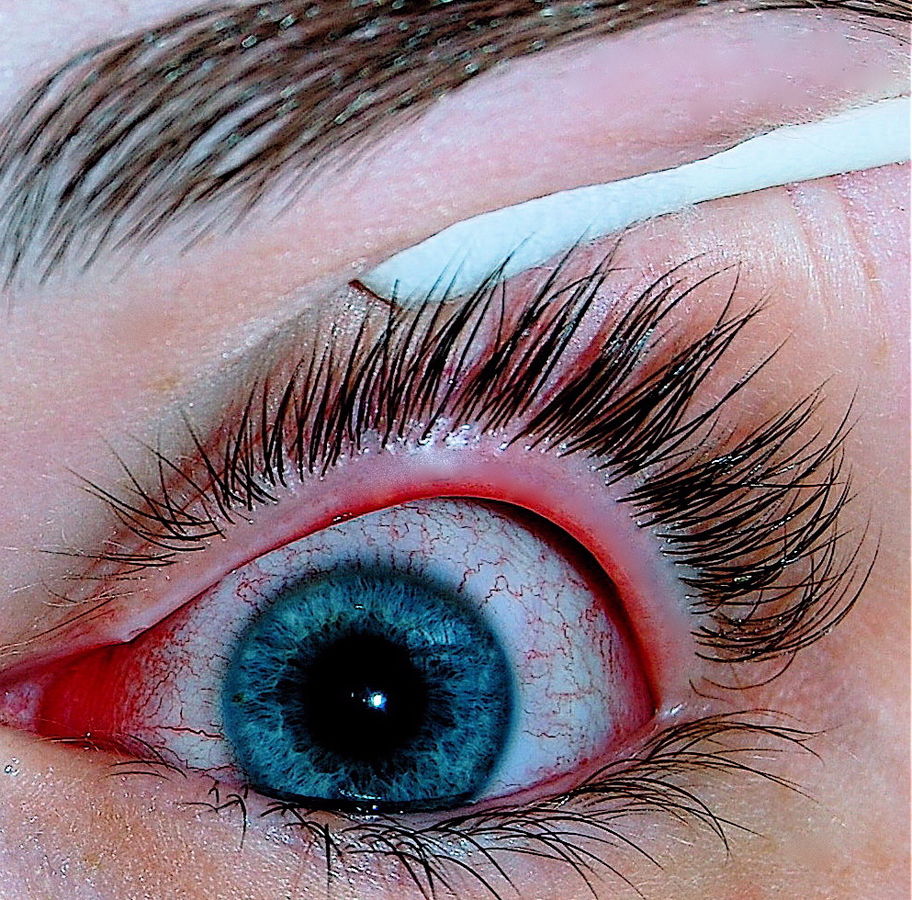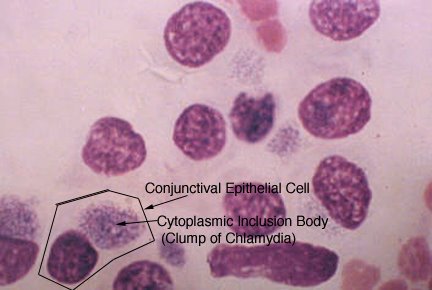Conjunctivitis pathophysiology: Difference between revisions
No edit summary |
No edit summary |
||
| Line 18: | Line 18: | ||
[[Newborns]] can be infected by [[bacteria]] in the [[birth canal]]. This condition is called [[ophthalmia neonatorum]], and it must be treated immediately to preserve [[eyesight]]. Additionally, [[neonatal]] conjunctivitis is a red eye in a [[newborn]] caused by [[irritation]], a blocked [[tear duct]], or [[infection]]. | |||
Development of '''[[Allergic Conjunctivitis]]''' is result of [[type I hypersensitivity reactions]] involving the conjunctiva. <ref name="pmid26681960">{{cite journal| author=Kyei S, Koffuor GA, Ramkissoon P, Abokyi S, Owusu-Afriyie O, Wiredu EA| title=Possible Mechanism of Action of the Antiallergic Effect of an Aqueous Extract of Heliotropium indicum L. in Ovalbumin-Induced Allergic Conjunctivitis. | journal=J Allergy (Cairo) | year= 2015 | volume= 2015 | issue= | pages= 245370 | pmid=26681960 | doi=10.1155/2015/245370 | pmc=4657065 | url=http://www.ncbi.nlm.nih.gov/entrez/eutils/elink.fcgi?dbfrom=pubmed&tool=sumsearch.org/cite&retmode=ref&cmd=prlinks&id=26681960 }} </ref> | Development of '''[[Allergic Conjunctivitis]]''' is result of [[type I hypersensitivity reactions]] involving the conjunctiva. <ref name="pmid26681960">{{cite journal| author=Kyei S, Koffuor GA, Ramkissoon P, Abokyi S, Owusu-Afriyie O, Wiredu EA| title=Possible Mechanism of Action of the Antiallergic Effect of an Aqueous Extract of Heliotropium indicum L. in Ovalbumin-Induced Allergic Conjunctivitis. | journal=J Allergy (Cairo) | year= 2015 | volume= 2015 | issue= | pages= 245370 | pmid=26681960 | doi=10.1155/2015/245370 | pmc=4657065 | url=http://www.ncbi.nlm.nih.gov/entrez/eutils/elink.fcgi?dbfrom=pubmed&tool=sumsearch.org/cite&retmode=ref&cmd=prlinks&id=26681960 }} </ref> | ||
*[[IgE | *[[IgE]] and [[Mast cell]] play an important role in these allergic inflammations | ||
*There is a strong association with [[atopic dermatitis]] and [[Allergic Conjunctivitis]] | |||
In '''[[Giant papillary conjunctivitis]]''' combination of type I and [[type IV hypersensitivity reactions]] may be responsible. Also prolonged mechanical irritation to the [[superior tarsal]] conjunctiva, of the upper lid, from any of a variety of [[foreign bodies]] may also be a contributing factor in Giant papillary conjunctivitis.<ref name="pmid7886881">{{cite journal| author=Donshik PC| title=Giant papillary conjunctivitis. | journal=Trans Am Ophthalmol Soc | year= 1994 | volume= 92 | issue= | pages= 687-744 | pmid=7886881 | doi= | pmc=1298525 | url=http://www.ncbi.nlm.nih.gov/entrez/eutils/elink.fcgi?dbfrom=pubmed&tool=sumsearch.org/cite&retmode=ref&cmd=prlinks&id=7886881 }} </ref><ref name="pmid10703125">{{cite journal| author=Donshik PC, Porazinski AD| title=Giant papillary conjunctivitis in frequent-replacement contact lens wearers: a retrospective study. | journal=Trans Am Ophthalmol Soc | year= 1999 | volume= 97 | issue= | pages= 205-16; discussion 216-20 | pmid=10703125 | doi= | pmc=1298261 | url=http://www.ncbi.nlm.nih.gov/entrez/eutils/elink.fcgi?dbfrom=pubmed&tool=sumsearch.org/cite&retmode=ref&cmd=prlinks&id=10703125 }} </ref> | In '''[[Giant papillary conjunctivitis]]''' combination of type I and [[type IV hypersensitivity reactions]] may be responsible. Also prolonged mechanical irritation to the [[superior tarsal]] conjunctiva, of the upper lid, from any of a variety of [[foreign bodies]] may also be a contributing factor in Giant papillary conjunctivitis.<ref name="pmid7886881">{{cite journal| author=Donshik PC| title=Giant papillary conjunctivitis. | journal=Trans Am Ophthalmol Soc | year= 1994 | volume= 92 | issue= | pages= 687-744 | pmid=7886881 | doi= | pmc=1298525 | url=http://www.ncbi.nlm.nih.gov/entrez/eutils/elink.fcgi?dbfrom=pubmed&tool=sumsearch.org/cite&retmode=ref&cmd=prlinks&id=7886881 }} </ref><ref name="pmid10703125">{{cite journal| author=Donshik PC, Porazinski AD| title=Giant papillary conjunctivitis in frequent-replacement contact lens wearers: a retrospective study. | journal=Trans Am Ophthalmol Soc | year= 1999 | volume= 97 | issue= | pages= 205-16; discussion 216-20 | pmid=10703125 | doi= | pmc=1298261 | url=http://www.ncbi.nlm.nih.gov/entrez/eutils/elink.fcgi?dbfrom=pubmed&tool=sumsearch.org/cite&retmode=ref&cmd=prlinks&id=10703125 }} </ref> | ||
[[Airborne antigens]] may be involved in the pathogenesis of Allergic Conjunctivitis. Common [[airborne antigens]], include:<ref name="pmid19134019">{{cite journal| author=Malling HJ, Montagut A, Melac M, Patriarca G, Panzner P, Seberova E et al.| title=Efficacy and safety of 5-grass pollen sublingual immunotherapy tablets in patients with different clinical profiles of allergic rhinoconjunctivitis. | journal=Clin Exp Allergy | year= 2009 | volume= 39 | issue= 3 | pages= 387-93 | pmid=19134019 | doi=10.1111/j.1365-2222.2008.03152.x | pmc=4233960 | url=http://www.ncbi.nlm.nih.gov/entrez/eutils/elink.fcgi?dbfrom=pubmed&tool=sumsearch.org/cite&retmode=ref&cmd=prlinks&id=19134019 }} </ref><ref name="pmid17967188">{{cite journal| author=Kämpe M, Stålenheim G, Janson C, Stolt I, Carlson M| title=Systemic and local eosinophil inflammation during the birch pollen season in allergic patients with predominant rhinitis or asthma. | journal=Clin Mol Allergy | year= 2007 | volume= 5 | issue= | pages= 4 | pmid=17967188 | doi=10.1186/1476-7961-5-4 | pmc=2174506 | url=http://www.ncbi.nlm.nih.gov/entrez/eutils/elink.fcgi?dbfrom=pubmed&tool=sumsearch.org/cite&retmode=ref&cmd=prlinks&id=17967188 }} </ref> | [[Airborne antigens]] may be involved in the pathogenesis of Allergic Conjunctivitis. Common [[airborne antigens]], include:<ref name="pmid19134019">{{cite journal| author=Malling HJ, Montagut A, Melac M, Patriarca G, Panzner P, Seberova E et al.| title=Efficacy and safety of 5-grass pollen sublingual immunotherapy tablets in patients with different clinical profiles of allergic rhinoconjunctivitis. | journal=Clin Exp Allergy | year= 2009 | volume= 39 | issue= 3 | pages= 387-93 | pmid=19134019 | doi=10.1111/j.1365-2222.2008.03152.x | pmc=4233960 | url=http://www.ncbi.nlm.nih.gov/entrez/eutils/elink.fcgi?dbfrom=pubmed&tool=sumsearch.org/cite&retmode=ref&cmd=prlinks&id=19134019 }} </ref><ref name="pmid17967188">{{cite journal| author=Kämpe M, Stålenheim G, Janson C, Stolt I, Carlson M| title=Systemic and local eosinophil inflammation during the birch pollen season in allergic patients with predominant rhinitis or asthma. | journal=Clin Mol Allergy | year= 2007 | volume= 5 | issue= | pages= 4 | pmid=17967188 | doi=10.1186/1476-7961-5-4 | pmc=2174506 | url=http://www.ncbi.nlm.nih.gov/entrez/eutils/elink.fcgi?dbfrom=pubmed&tool=sumsearch.org/cite&retmode=ref&cmd=prlinks&id=17967188 }} </ref> | ||
| Line 27: | Line 28: | ||
* Grass, | * Grass, | ||
* Weeds, | * Weeds, | ||
'''Keratoconjunctivitis sicca''' or [[dry eye syndrome]] is multifactorial disease and associated with different medical conditions such as:<ref name="pmid27213053">{{cite journal| author=Zhang X, Zhao L, Deng S, Sun X, Wang N| title=Dry Eye Syndrome in Patients with Diabetes Mellitus: Prevalence, Etiology, and Clinical Characteristics. | journal=J Ophthalmol | year= 2016 | volume= 2016 | issue= | pages= 8201053 | pmid=27213053 | doi=10.1155/2016/8201053 | pmc=4861815 | url=http://www.ncbi.nlm.nih.gov/entrez/eutils/elink.fcgi?dbfrom=pubmed&tool=sumsearch.org/cite&retmode=ref&cmd=prlinks&id=27213053 }} </ref><ref name="pmid27179980">{{cite journal| author=Sivaraman KR, Jivrajka RV, Soin K, Bouchard CS, Movahedan A, Shorter E et al.| title=Superior Limbic Keratoconjunctivitis-like Inflammation in Patients with Chronic Graft-Versus-Host Disease. | journal=Ocul Surf | year= 2016 | volume= | issue= | pages= | pmid=27179980 | doi=10.1016/j.jtos.2016.04.003 | pmc= | url=http://www.ncbi.nlm.nih.gov/entrez/eutils/elink.fcgi?dbfrom=pubmed&tool=sumsearch.org/cite&retmode=ref&cmd=prlinks&id=27179980 }} </ref> | |||
* [[Sjögren's syndrome]] | |||
* [[Ocular surface disease]] | |||
* Ocular allergy | |||
* Dysfunction of the [[lacrimal gland]] with reduced tear production and Mucin deficiency | |||
Keratoconjunctivitis sicca-associated [[Sjögren's syndrome]] may be is the result of an auto immunological sequelae which can lead to chronic inflammatory state with production of auto antibodies, such as: [[antinuclear antibody]] (ANA), [[rheumatoid factor]] (RF), fodrin (a [[cytoskeletal protein]]), the [[muscarinic]] M3 receptor, or [[Sjögren's syndrome]]-specific antibodies ([[anti-RO]] and [[anti-LA]]) | |||
Focal [[CD4+ T cells]] and [[B cells]] infiltration of the lacrimal gland can induce [[apoptosis]] in the conjunctiva and lacrimal glands and this results in dysfunction of the lacrimal gland with reduced tear production. | |||
This results in dysfunction of the lacrimal gland with reduced tear production, as well as loss of response to nerve stimulation and less reflex tearing. Active T-lymphocytic infiltrate in the conjunctiva has also been reported in non-SS dry eye syndrome. | |||
===Gross Pathology=== | |||
[[Image:An eye with viral conjunctivitis.jpg|thumb|left|200px|frame|Viral Conjunctivitis<ref> Image Courtesy of Joyhil09 [https://commons.wikimedia.org/wiki/File:An_eye_with_viral_conjunctivitis.jpg]</ref>]] | |||
| Line 51: | Line 54: | ||
===Microscopic Pathology=== | ===Microscopic Pathology=== | ||
[[Image:chlamydial conjunctivitis.jpg|thumb|left|200px|Chlamydial conjunctivitis (Day 5-14)<ref>http://picasaweb.google.com/mcmumbi/USMLEIIImages</ref>]] | [[Image:chlamydial conjunctivitis.jpg|thumb|left|200px|Chlamydial conjunctivitis (Day 5-14)<ref>http://picasaweb.google.com/mcmumbi/USMLEIIImages</ref>]] | ||
| Line 79: | Line 79: | ||
[[Category:Inflammations]] | [[Category:Inflammations]] | ||
[[Category:Ophthalmology]] | [[Category:Ophthalmology]] | ||
[[Category:Rheumatology]] | |||
[[Category:Overview complete]] | [[Category:Overview complete]] | ||
[[Category:Disease]] | [[Category:Disease]] | ||
Revision as of 16:31, 23 June 2016
Editor-In-Chief: C. Michael Gibson, M.S., M.D. [2]
|
Conjunctivitis Microchapters |
|
Diagnosis |
|---|
|
Treatment |
|
Case Studies |
|
Conjunctivitis pathophysiology On the Web |
|
American Roentgen Ray Society Images of Conjunctivitis pathophysiology |
|
Risk calculators and risk factors for Conjunctivitis pathophysiology |
Please help WikiDoc by adding more content here. It's easy! Click here to learn about editing.
Pathophysiology
Infective Conjunctivitis is spread from:
- Direct contact with the infected person’s eye drainage or drainage from the person’s cough, sneeze, or runny nose
- Contact with the infected person’s fingers, hands or objects that may have the infected person’s drainage on them (e.g. eye makeup applicators, towels, shared eye medications)
- Adjacent infectious sites (rubbing of the eyes)
Any change in the host defense or in the species of normal flora of the eye (such as streptococci, staphylococci, and corynebacteria) can lead to clinical infection and Conjunctivitis.[1] Change in the flora can occur by:
- External contamination
- Contact lens wear
- Swimming
Newborns can be infected by bacteria in the birth canal. This condition is called ophthalmia neonatorum, and it must be treated immediately to preserve eyesight. Additionally, neonatal conjunctivitis is a red eye in a newborn caused by irritation, a blocked tear duct, or infection.
Development of Allergic Conjunctivitis is result of type I hypersensitivity reactions involving the conjunctiva. [2]
- IgE and Mast cell play an important role in these allergic inflammations
- There is a strong association with atopic dermatitis and Allergic Conjunctivitis
In Giant papillary conjunctivitis combination of type I and type IV hypersensitivity reactions may be responsible. Also prolonged mechanical irritation to the superior tarsal conjunctiva, of the upper lid, from any of a variety of foreign bodies may also be a contributing factor in Giant papillary conjunctivitis.[3][4] Airborne antigens may be involved in the pathogenesis of Allergic Conjunctivitis. Common airborne antigens, include:[5][6]
- Pollen,
- Grass,
- Weeds,
Keratoconjunctivitis sicca or dry eye syndrome is multifactorial disease and associated with different medical conditions such as:[7][8]
- Sjögren's syndrome
- Ocular surface disease
- Ocular allergy
- Dysfunction of the lacrimal gland with reduced tear production and Mucin deficiency
Keratoconjunctivitis sicca-associated Sjögren's syndrome may be is the result of an auto immunological sequelae which can lead to chronic inflammatory state with production of auto antibodies, such as: antinuclear antibody (ANA), rheumatoid factor (RF), fodrin (a cytoskeletal protein), the muscarinic M3 receptor, or Sjögren's syndrome-specific antibodies (anti-RO and anti-LA) Focal CD4+ T cells and B cells infiltration of the lacrimal gland can induce apoptosis in the conjunctiva and lacrimal glands and this results in dysfunction of the lacrimal gland with reduced tear production.
This results in dysfunction of the lacrimal gland with reduced tear production, as well as loss of response to nerve stimulation and less reflex tearing. Active T-lymphocytic infiltrate in the conjunctiva has also been reported in non-SS dry eye syndrome.
Gross Pathology

Microscopic Pathology

References
- ↑ Everitt H, Kumar S, Little P (2003). "A qualitative study of patients' perceptions of acute infective conjunctivitis". Br J Gen Pract. 53 (486): 36–41. PMC 1314490. PMID 12564275.
- ↑ Kyei S, Koffuor GA, Ramkissoon P, Abokyi S, Owusu-Afriyie O, Wiredu EA (2015). "Possible Mechanism of Action of the Antiallergic Effect of an Aqueous Extract of Heliotropium indicum L. in Ovalbumin-Induced Allergic Conjunctivitis". J Allergy (Cairo). 2015: 245370. doi:10.1155/2015/245370. PMC 4657065. PMID 26681960.
- ↑ Donshik PC (1994). "Giant papillary conjunctivitis". Trans Am Ophthalmol Soc. 92: 687–744. PMC 1298525. PMID 7886881.
- ↑ Donshik PC, Porazinski AD (1999). "Giant papillary conjunctivitis in frequent-replacement contact lens wearers: a retrospective study". Trans Am Ophthalmol Soc. 97: 205–16, discussion 216-20. PMC 1298261. PMID 10703125.
- ↑ Malling HJ, Montagut A, Melac M, Patriarca G, Panzner P, Seberova E; et al. (2009). "Efficacy and safety of 5-grass pollen sublingual immunotherapy tablets in patients with different clinical profiles of allergic rhinoconjunctivitis". Clin Exp Allergy. 39 (3): 387–93. doi:10.1111/j.1365-2222.2008.03152.x. PMC 4233960. PMID 19134019.
- ↑ Kämpe M, Stålenheim G, Janson C, Stolt I, Carlson M (2007). "Systemic and local eosinophil inflammation during the birch pollen season in allergic patients with predominant rhinitis or asthma". Clin Mol Allergy. 5: 4. doi:10.1186/1476-7961-5-4. PMC 2174506. PMID 17967188.
- ↑ Zhang X, Zhao L, Deng S, Sun X, Wang N (2016). "Dry Eye Syndrome in Patients with Diabetes Mellitus: Prevalence, Etiology, and Clinical Characteristics". J Ophthalmol. 2016: 8201053. doi:10.1155/2016/8201053. PMC 4861815. PMID 27213053.
- ↑ Sivaraman KR, Jivrajka RV, Soin K, Bouchard CS, Movahedan A, Shorter E; et al. (2016). "Superior Limbic Keratoconjunctivitis-like Inflammation in Patients with Chronic Graft-Versus-Host Disease". Ocul Surf. doi:10.1016/j.jtos.2016.04.003. PMID 27179980.
- ↑ Image Courtesy of Joyhil09 [1]
- ↑ http://picasaweb.google.com/mcmumbi/USMLEIIImages